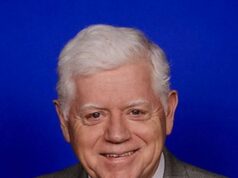Washington, D.C. – December 22, 2015 – (RealEstateRama) — American wind power just passed the 70 gigawatt (GW) mark, meaning enough wind turbine capacity is now installed to supply over 19 million typical American homes with low-cost electricity.
The announcement comes as political leaders from around the world, including the U.S., reached a historic agreement this month to reduce carbon pollution, further increasing the demand for zero-emission wind energy.
“This American wind power success story just gets better. There’s now enough wind power installed to meet the equivalent of total electricity demand in Oklahoma, Nebraska, Kansas, Colorado and Wyoming,” said Tom Kiernan, CEO of the American Wind Energy Association (AWEA). “Wind energy is the biggest, fastest and cheapest way we can cut carbon pollution here in the U.S., and as wind power grows, so will savings for American families and businesses all across the country.”
The milestone was achieved in November, and was documented and announced today by AWEA. Achieving it means there’s now enough wind power installed in America to light the Rockefeller Center Christmas tree for over 440,000 years. Said another way, each year America generates enough electricity to drive 26 million electric cars around the world.
Wind power crossed the 50 GW and 60 GW thresholds in 2012, as developers rushed to complete projects before the expiration of the Production Tax Credit (PTC). The subsequent policy uncertainty in 2013 derailed that momentum, and wind energy installations declined by 92 percent that year. Recent extensions have resulted in a near-record amount of construction now underway across the U.S.
Last week, Congress passed a multi-year extension of the performance-based PTC and alternative Investment Tax Credit as part of the government spending bill, securing the predictable business environment needed to keep U.S. factories open and further scale up American wind power. Previous short-term extensions of the wind tax incentives helped spur a near-record of more than 13,250 megawatts (MW) of wind capacity currently under construction in the U.S., with an additional 4,100 MW in advanced stages of development. This year’s multi-year extension is expected to add to that number.
There are currently over 50,000 operating wind turbines in the U.S., at more than 980 utility-scale wind farms across 40 states and Puerto Rico. American wind power began this year with a capacity of 65,877 MW, with 956 utility-scale wind projects in 39 states and Puerto Rico, and continues to add more this month, which will push the 2015 total well above the 70,000 MW (70 GW) being announced today.
Among the new wind farms completed so far this quarter which helped push wind over 70 GW are projects in Colorado, Maine, Kansas, Oklahoma, Texas, and North Dakota. Other recent additions include the first utility-scale project to be completed in Connecticut. North Carolina announced the start of construction of its first utility-scale wind farm in October. Once completed, the project will be the largest in the Southeast, and will bring the number of U.S. states with a commercial-scale wind farm to 41.
Wind hits new production records
Wind energy production also blew away records across the U.S. last month, as grid operators in Texas and the Midwest reported output peak records in November.
- ERCOT, the primary grid operator in Texas, saw wind energy peak at 12,971 MW, and also saw wind reliably meet more than 43 percent of electricity demand at one point the following day. Overall, wind supplied a full 18.4 percent of ERCOT’s total demand in November.
- Wind supplied 12,614 MW in MISO, the grid operator for parts of 12 Midwest states, and one of the world’s largest energy markets.
- Wind production in November hit 9,564 MW in SPP, grid operator for all or parts of eight states.
- On the main Colorado grid, wind provided 66.4 percent of the electricity at one point in November.
These real-world examples demonstrate how utilities are reliably integrating large amounts of wind energy today.
That’s good news for states in the market for low-cost, low-emissions energy solutions to comply with EPA’s Clean Power Plan. Wind energy is a rapidly deployable solution that protects consumers against fuel price uncertainty while drastically reducing emissions.
The cost of wind-generated electricity has fallen 66 percent in six years. By locking in long-term contracts with wind developers, electric utilities can protect ratepayers from future fuel price shocks. A recent study by the Energy Information Administration found that wind energy consistently emerged as the most cost-effective method of reducing emissions, supplying 57 percent of the additional energy in the lowest-cost compliance solution for the Clean Power Plan.
The Department of Energy’s recent Wind Vision report says U.S. wind energy is poised to double from nearly five percent of U.S. electricity today to 10 percent by 2020, and double again to 20 percent by 2030. The report found that hitting that target could create 380,000 American jobs.
For a library of up-to-date images of wind energy free for use, please use this link.
AWEA is the national trade association of the U.S. wind energy industry, with 1,000 member companies, including global leaders in wind power and energy development, wind turbine manufacturing, component and service suppliers, and the western hemisphere’s largest wind power trade show, the AWEA WINDPOWER Conference & Exhibition, which takes place next in New Orleans, LA, May 23-26, 2016. AWEA is the voice of wind energy in the U.S., promoting renewable energy to power a cleaner, stronger America. Look up information on wind energy at theAWEA website. Find insight on industry issues at AWEA’s blog Into the Wind. Join AWEA on Facebook. Follow AWEA on Twitter.














